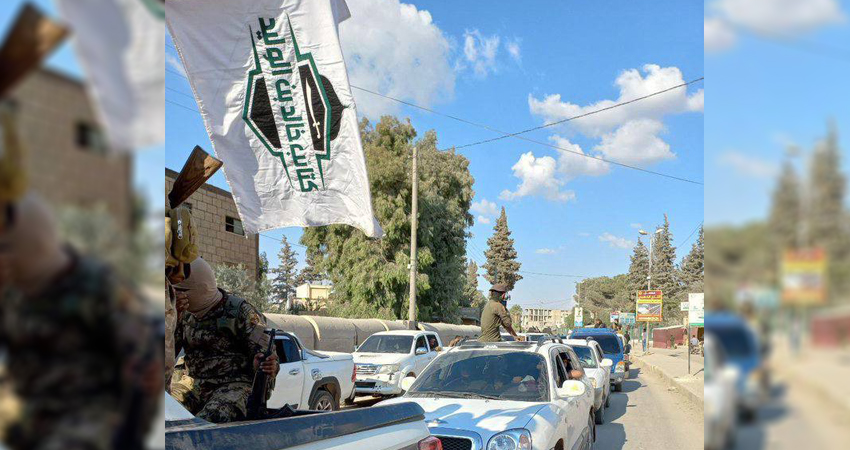1. Introduction
The assassination of the media activist Muhammad Abdul Latif, locally known as Muhammad Abu Ghannoum, and his pregnant wife in al-Bab city on 7 October 2022 caused a critical shift in the map of military control in Aleppo province, north of Syria. The assassination sent a wave of anger through the local community. It triggered al-Bab’s residents to call for civil disobedience, particularly after investigations corroborated the involvement of commanders and militants of the al-Hamza/al-Hamzat Division in the activist’s murder.
Unmindful of the outraged populace, several armed groups of the opposition’s Syrian National Army (SNA) took advantage of the assassination to expand their control at the expense of fellow armed groups. After the investigation revealed the security cell that perpetrated the assassination—which members have confessed to being members from the SNA-affiliated al-Hamza/al-Hamzat Division—factions from the SNA’s 3rd Legion, specifically the Levant Front/al-Jabha al-Shamiya and the Army of Islam/Jaysh al-Islam, attacked the division’s military centers in the al-Bab city on 12 October 2022. The geographical scope of the clashes among these groups widened and stretched to Jarabulus and the Afrin region.
In the aftermath of these clashes, the area witnessed the birth of new military affiliations. Additionally, the Hay’at Tahrir al-Sham (HTS-former al-Nusra Front), designated as a terrorist group globally, invested in the chaos to enlarge its control areas and attempted to establish hegemony over northern rural Aleppo. However, the HTS stopped its expansion in Afrin after Türkiye broke off the clashes among the factions and ordered them to restore the status quo ante. The armed groups ended fighting but did not return to their pre-dispute positions.
The HTS did not entirely remove its forces from the Afrin region. Instead, it preserved an extensive presence under cover from its affiliated factions. In tandem, its militants and members heavily infiltrated the ranks of the civil and military police services there. Today, the HTS is stationed primarily in Afrin city and the districts of Rajo and Jindires.
Notably, the tremor that hit Syria-Türkiye revealed the actual scale of the HTS’s presence in the Afrin region, in terms of military and service facilities. The quake gave the HTS another pretext to branch out further in Afrin, exploiting the rampant chaos across northwestern Syria and the population’s desperate need for humanitarian assistance this time. To achieve its purposes, the HTS deployed its General Security Service to affected areas and sent its militants to partake in search and rescue efforts.
Only recently, the HTS exploited another horrifying crime and ensuing havoc in the Afrin region. The HTS deployed new batches of its fighters to Afrin and controlled new positions across the area, particularly in the Jindires district, where the Eastern Army/Jaysh al-Sharqiya shot and killed four civilian Kurds on the eve of the Newroz/Nawroz celebrations. In response, 155 Syrian civil society organizations demanded that the United Nations intervene to stop the HTS’s expansion in the Afrin region and other areas north of Syria—especially after the HTS used the death of Syrians as a pretext to enter Jindires and its suburbs and take over SNA military centers there.
In this brief report, Syrians for Truth and Justice (STJ) sheds light on the HTS’s control dynamics in the Afrin region. To this end, STJ carried out 13 interviews. STJ talked to 11 military sources, mostly from the SNA, who explained the contexts and the alliances that led to the HTS’s control of Afrin, and two local sources, including a relief worker, who commented on the HTS’s activities and role in the region post the earthquake. Additionally, the digital forensic expert with STJ obtained open-source images, which verify the HTS has an active presence in the region militarily and also in the domain of services.
2. The HTS Northward Expansion Strategy
The sources STJ met with stressed that the HTS’s efforts to expand to northern rural Aleppo are not new, nor did they start with the factional clashes in mid-2022. The sources pointed out that the HTS effectively attempted to sprawl in the area in early 2022. The HTS, therefore, held meetings with SNA commanders and pitched them a “project to unify the administration” of Idlib and northern rural Aleppo. Nevertheless, the HTS’s efforts failed because the SNA’s 3rd Legion—the Levant Front/al-Jabha al-Shamiya and the Army of Islam/Jaysh al-Islam, turned down the proposed project and since these two factions were working on similar enterprises.
When the joint-administration idea reached a dead end, the HTS adopted a different policy. It worked to attract SNA-affiliated factions to its side. To this end, the HTS held individual meetings with the commanders of the armed groups over the first months of 2022 and sealed unpublicized deals with them. The agreements later paved its path toward the Afrin region. The HTS established a military presence in Afrin and controlled several of its major cities.
The HTS started to have an actual presence in the Afrin region in June 2022, when violent intra-factional clashes broke out between its rival armed groups. The internal fighting involved the Levant Front/al-Jabha al-Shamiya, led by Muhannad al-Khalaf (Abu Ahmed Nour), and the Army of Islam/Jaysh al-Islam, led by ‘Issam Buaidani, on the one hand, and the 32nd Division (Ahrar al-Sham-Eastern Sector), led by ‘Mohammed Rami (Abu Haidara), on the other hand. The hostilities erupted after the 32nd Division left the ranks of the Levant Front/al-Jabha al-Shamiya and asked for backup from the HTS. Accordingly, the HTS deployed huge military convoys from Idlib province to the Afrin region.
Later, the HTS withdrew most of the convoys and stationed only a few military groups in several villages across Afrin to support the 32nd Division. Through the military assistance it dispatched, the HTS, classified in the Global Terrorism Index, reached the Afrin region for the first time. This marked the onset of its permanent presence there, as it still had forces stationed in Afrin by the end of June 2022.
Based on the accounts of the sources, STJ concluded that a number of the Türkiye-baked SNA factions, primarily the al-Hamza/al-Hamzat Division, led by Saif Abu Bakr, and the Suleiman Shah Brigade, led by Muhammad al-Jasim and nicknamed Abu Amsha, had an unmediated contact with the HTS in Idlib in October 2022. Additionally, these two factions facilitated the HTS’s entry into the Afrin region after the assassination of the media activist Abu Ghannoum. Consequently, the HTS spread in Afrin and controlled the internal commercial crossings that connect Idlib and northern rural Aleppo. The HTS embarked on the incursion under the guise of protecting its partners, the division and the brigade, from the operation the SNA’s 3rd Legion initiated in response to the large-scale clashes among the factions.
Following the initial incursion into the region, the HTS did not withdraw entirely despite Türkiye’s unmediated intervention to disengage the clashing groups. The HTS stationed its militants in the military centers of its allied factions, the division and the brigade, and deployed batches of its General Security Services as a parallel security force to operate along with the military and civil police that already existed in Afrin.
Commenting on the HTS’s expansion strategy, a military commander from the SNA’s 3rd Legion (source 1) narrated:
“The project the HTS, led by al-Julani, proposed to the Levant Front/al-Jabha al-Shamiya, led by Abu Ahmad Nour, revolved around establishing a joint administration for the areas of Idlib, Aleppo’s northern countryside, Tal Abyad, and Ras al-Ayn. The HTS and the Front engaged in negotiations that ultimately failed. [The failure] is attributed to the Front’s Majlis-ash-Shura (advisory council), which sees that the Front and other SNA factions can manage the affairs of Aleppo’s northern countryside without the HTS’s help, which is designated as a terrorist group internationally.”
The source added:
“After this attempt by the HTS, the Levant Front/al-Jabha al-Shamiya tried to build an alliance with other SNA factions by establishing the Azm [Unified Command Room]. This project also failed because the other factions were not invested enough. Only the Army of Islam/Jaysh al-Islam entered into a close alliance with the Front. Notably, the Army is the HTS’s archenemy.”
| In tandem with the Levant Front/al-Jabha al-Shamiya’s effort to rally allies, the HTS sought to seal agreements with prominent SNA factions, notably the al-Hamza/al-Hazmat Division, the Sultan Murad Division, and the Suleiman Shah Brigade (also known as al-Amshat). |
STJ reached out to a high-ranking officer from the al-Hamza/al-Hazmat Division (source 2). He provided insights into the tri-party agreement signed by the Division, the HTS, and the Suleiman Shah Brigade (also known as al-Amshat), which included a “collective defense” clause. The officer narrated:
“In March 2022, the HTS on one side and the al-Hamza/al-Hazmat Division and the Suleiman Shah Brigade (also known as al-Amshat) on the other signed an undeclared security agreement. The agreement provides for mutual attack and defense in cases of threats or attacks on any of the agreement’s parties. The agreement also provides for the exchange of unlimited weapons, munitions, and fighters.”
The HTS signed a second security agreement with the Sultan Murad Division one month after the tri-party deal. The agreement provided that the Sultan Murad Division must remain neutral in future clashes, if any shall erupt between the HTS and other factions. A high-ranking officer from the SNA’s 2rd Legion (source 3), who attended the agreement’s meeting, said:
“In April 2022, the commanders of the HTS, Abu Mohammad al-Julani, and of the Sultan Murad Division, Fahim Issa, met in Ras Elhisn village in Idlib’s countryside. They agreed that the Sultan Murad Division, consisting primarily of Turkmen fighters, shall remain on the sidelines during military disputes between the HTS and the Levant Front/al-Jabha al-Shamiya. Additionally, [the agreement] provided that the Division shall continue to maintain good relations with both factions. The Sultan Murad Division adopted this stance under directives from the Turkish Intelligence.”
The clashes between the Levant Front/al-Jabha al-Shamiya and Ahrar al-Sham-Eastern Sector started soon after the HTS signed these agreements. The HTS, on its turn, took advantage of the clashes to create an inlet into Aleppo’s northern countryside. Commenting on the issue, a high ranking-officer from the Army of Islam/Jaysh al-Islam (source 4), operating under the mantle of the SNA’s 3rd Legion, recounted:
“After the agreement with the al-Hamza/al-Hazmat Division and the Suleiman Shah Brigade (also known as al-Amshat), the HTS tried to find a reason to enter Aleppo’s northern countryside, where it could militarily tackle the Levant Front/al-Jabha al-Shamiya. Therefore, the HTS capitalized on the problem of the Ahrar al-Sham-Eastern Sector, which had dissented from the Front. The HTS paid the salaries of Ahrar al-Sham’s fighters to enable them to make that maneuver. Additionally, the HTS deployed individual military and security members to join the Ahrar al-Sham, who would make HTS’s first steps into the Olive Branch and Euphrates Shield strips. However, the HTS made all these arrangements secretly to coordinate and prepare for a large-scale entry into the area.”
In May 2022, the National Reform Commission (NRC)—affiliated with the SNA and founded in September 2021 to resolve disputes within its ranks, attempted to settle the conflict between Ahrar al-Sham-Eastern Sector and the Levant Front/al-Jabha al-Shamiya. However, Ahrar al-Sham declared its split from the Front and joined the SNA’s 2nd Legion. Afterward, the Eastern Sector worked on boosting its forces, especially after members from the HTS joined its ranks and created a security cell in al-Bab and Afrin.
For additional information about the members Ahrar al-Sham deployed to the Afrin region and Aleppo’s northern countryside, STJ reached out to a member of the NRC, an operations officer from the Military Police, and a former high-ranking officer from the Ahrar al-Sham-Eastern Sector. The NRC member (source 5) narrated:
“The efforts of the HTS succeeded. The Ahrar al-Sham-Eastern Sector declared defection from the Levant Front/al-Jabha al-Shamiya under orders from the al-Julani, commander of the HTS. In response, the Front attacked the military centers of the Eastern Sector. This was al-Julani’s goal because he needed the pretext to enter Aleppo’s northern countryside. Indeed, clashes started and ended promptly under a ceasefire agreement, which also provided that the Front returns the centers it took over to the Eastern Sector.”
For his part, the operations officer (source 6) from the Military Police in the Afrin region narrated:
“[We] monitored a marked increase in the manpower of the Ahrar al-Sham-Eastern Sector. The extra numbers consist of an HTS-affiliated battalion and security cell tasked with collecting information, designing military plans for a comprehensive confrontation with Levant Front/al-Jabha al-Shamiya, and establishing a logistical base capable of feeding the [forces involved] in the attack with supplies.”
Elaborating on the role of the HTS security cell, a high-ranking officer who defected from the Ahrar al-Sham-Eastern Sector (source 7) said:
“The HTS security cell, which joined the ranks of Ahrar al-Sham, started obtaining information about the factions, their locations, the number of their fighters, and the weapons they use. Additionally, the cell had plans to carry out organized incursions into the Afrin region. Notably, the cell failed similar attempts in al-Bab in Aleppo’s northern countryside, where the Islamic Movement of the Free Men of the Levant/Harakat Ahrar al-Sham al-Islamiyya operated and offered cover to the HTS. The plans did not materialize due to the Army of Islam/Jaysh al-Islam’s close surveillance of the cell, which limited its spread and hampered its efforts.”
3. Military Confrontations Resumed in October 2022
On late 10 October, the SNA’s 3rd Legion—the Levant Front/al-Jabha al-Shamiya and the Army of Islam/Jaysh al-Islam, and the al-Hamza/al-Hamzat Division resumed their battles in the al-Bab city in Aleppo’s northern countryside, after the Division was revealed as has been involved in the assassination of the media activist Abu Ghannoum.
As the clashes between the two sides stretched beyond al-Bab into the Afrin region, several factional agreements were disclosed, especially the tri-party agreement between the HTS, the al-Hamza/al-Hamzat Division, and the Suleiman Shah Brigade (also known as al-Amshat). The factional affiliations underwent critical alterations and settled into the following current alliances:
| Alliance 1: The SNA’s 3rd Legion, comprising of the Levant Front/al-Jabha al-Shamiya and the Army of Islam/Jaysh al-Islam.
Alliance 2: The HTS and several SNA factions, particularly al-Hamza/al-Hamzat Division, the Suleiman Shah Brigade (also known as al-Amshat), the Islamic Movement of the Free Men of the Levant/Harakat Ahrar al-Sham al-Islamiyya. The remaining SNA factions took a neutral position during clashes and as the HTS expanded its presence in the region. The key of these factions is the Harakat al-Tahrir wal Bina (Liberation and Construction Movement-LCM), including the Eastern Army/Jaysh al-Sharqiya, Ahrar al-Sharqiya/ Free Men of the East, the Sultan Murad Division, the Sham Legion/Faylaq al-Sham and the Mu’tasim Division. |
At the time, the HTS sent massive reinforcements to the Afrin region, expelled the 3rd Legion, and settled there. Commenting on the HTS’s role in these confrontations, a high-ranking officer from the HTS (source 8) recounted:
“When the military confrontations between the 3rd Legion and the al-Hamza/al-Hamzat Division started, the HTS hastened to coordinate the largest attack ever on the legion. Additionally, the HTS sent massive reinforcements. It particularly commissioned the A’mer and Talha brigades, [both are affiliated with the HTS’s Security Office]. Notably, these brigades were the source of the security cell the HTS deployed to the region earlier. The HTS succeeded in expanding within the Afrin region, stopping at the Kafr Janneh village, where the forces of the 3rd Legion fortified and violent clashes broke out.”
The factional hostilities continued until 17 October. The HTS and its allies, the al-Hamza/al-Hamzat Division and the Suleiman Shah Brigade (also known as al-Amshat), failed to break through the defence lines the 3rd Legion established in Kafr Janneh village, near A’zaz city, after it withdrew from the Afrin region.
With the clashes ceasing at the village, there were talks of a Turkish-mediated truce between the fighting factions. For insights on the truce, STJ reached out to a high-ranking officer from the SNA (source 9). The source narrated:
“Despite the truce, the HTS distributed several of its sub-groups to military centers of the al-Hamza/al-Hamzat Division and the Suleiman Shah Brigade (also known as al-Amshat), while keeping the [allies’] flags hoisted in these centers to prepare for a larger attack on A’zaz city and control it. The HTS opted for this also fearing an attack from the 3rd Legion in an attempt to regain control over the areas it lost in the Afrin region. Additionally, the HTS deployed several of its members to the Civil Police checkpoints in the Afrin region. Moreover, the HTS started receiving complaints from the region’s residents and brought in garbage trucks after the Afrin Local Council stopped functioning due to military confrontations. The HTS also distributed bread once to IDP camps before the local council resumed its activities. The HTS’s most significant victory remains its control of the al-Hamaran crossing, which is the primary fuel outlet from the territories held by the Syrian Democratic Forces to north-western Syria.”
The officer added:
“[The region] remained calm for a few days before the HTS and its allied factions launched a fierce attack on Kaf Janneh village. However, the incursion failed to advance through the 3rd Legion’s extensive fortifications. At the time, the Turkish Intelligence Service intervened without mediation and ordered the fighting factions to disengage. Additionally, the Turkish military deployed armored vehicles in Afrin and demanded that the two sides remove their forces and engage in extensive negotiations in the presence of Turkish Intelligence. The Turkish mediation efforts were serious, especially after the Russian military bombarded the area and forced hundreds of families in IDP camps to escape toward the borders with Turkey.”
In a related context, a high-ranking Iraqi officer from the HTS (source 10) confirmed that Türkiye accepts the HTS’s presence in the Afrin region and that there is coordination and understanding between the two sides. In an exclusive account, the officer narrated:
“Following the second truce, Türkiye asked the HTS not to intervene in the work of the institutions it manages in northern Aleppo, including the civil and military police services, hospitals, schools, mosques, and local councils. Additionally, Türkiye demanded that the HTS preserve three of the SNA’s factions—the al-Hamza/al-Hamzat Division, the Suleiman Shah Brigade (also known as al-Amshat), and the Sultan Murad Division. During their meetings, Türkiye also informed [the HTS] that it is unconcerned by its efforts to control northern Aleppo or to eliminate the rest of the SNA’s factions.”
Notably, the assassination of the media activist Abu Ghannoum and the ensuing factional clashes contributed significantly to the HTS’s perpetual presence in the Afrin region, which is not limited to military deployment. After it entered Afrin, the HTS expanded the scope of its activities into various fields, including the security domain. Therefore, it established a Security Office/Service to function in parallel to the Civil Police, according to source 9. The previously cited high-ranking officer added:
“In reality, the HTS intends to establish full and effective control over Aleppo’s northern countryside and to disband the SNA factions, either through bringing them under its mantle or forcing them to surrender their weapons and abandon military work. After this, the HTS will move to the second phase. It would run the region politically and administratively and neutralize the Syrian Opposition Coalition (SOC) and the Syrian Interim Government (SIG). However, when Türkiye blatantly asked the HTS not to intervene in the work of the institutions it operates, the HTS maneuvered the situation by establishing an [entity] parallel to the SIG in the Afrin region. The HTS activated its General Security Service to disrupt the work of the Civil Police and undermine the SIG’s administrative role in the region.”
Additionally, an Afrin-based civilian eyewitness (source 11) narrated that the HTS General Security Service had arrested several former members of the Levant Front/al-Jabha al-Shamiya and the Army of Islam/Jaysh al-Islam. The source recounted:
“The HTS’s General Security Service started to undertake activities in Afrin city and carried out raid and arrest campaigns against several of the former affiliates of the Levant Front/al-Jabha al-Shamiya and the Army of Islam/Jaysh al-Islam. Informers accompanied the service during the raids.”
4. Visual Evidence of HTS’s Presence in Afrin
To corroborate the HTS’s military presence in the Afrin region, the digital forensic expert with STJ collected footage from various open sources, showing the armed group’s convoys entering Afrin and the deployment of its personnel in various locations across the region. One image even shows the HTS-manufactured armored vehicle named al-Buraq.
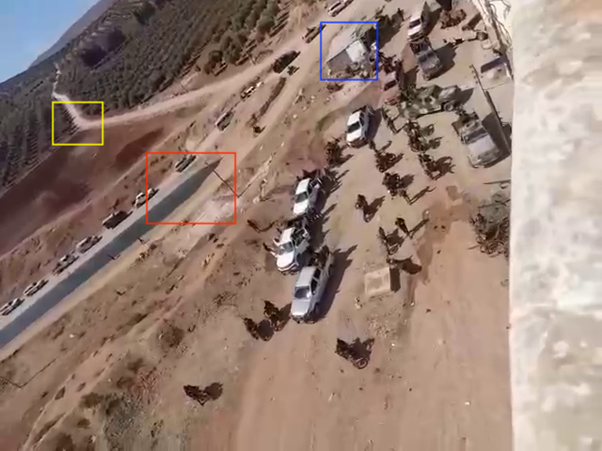 Image (1) – A convoy of HTS and Ahrar al-Sham fighters entering Afrin city, 13 October 2022 (source).
Image (1) – A convoy of HTS and Ahrar al-Sham fighters entering Afrin city, 13 October 2022 (source).
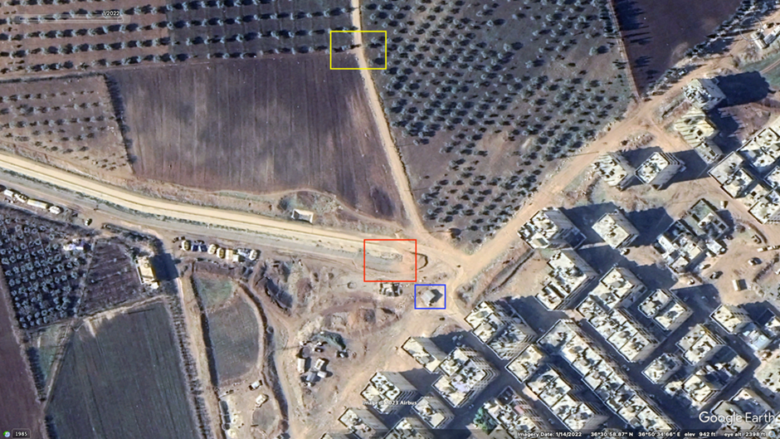 Image (2) – Geolocation of image (1). Coordinates: 36.516701, 36.842997
Image (2) – Geolocation of image (1). Coordinates: 36.516701, 36.842997
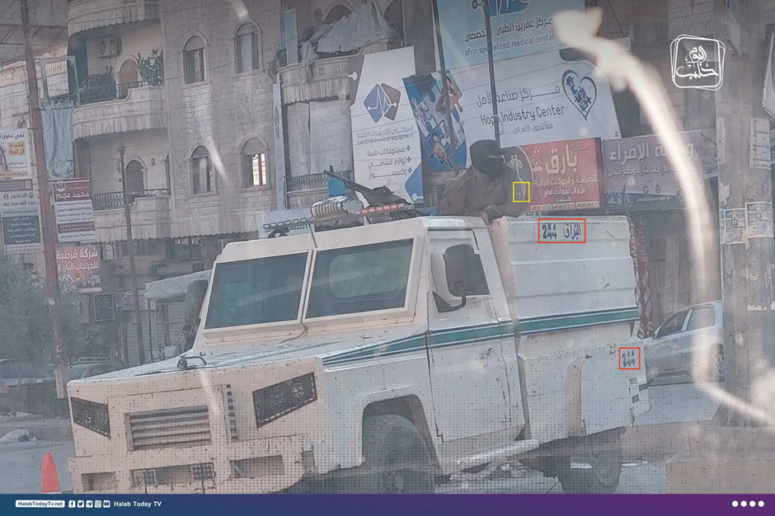 Image (3) – An HTS-manufactured armored vehicle named al-Buraq seen in Afrin city, 14 October 2022. This specific al-Buraq vehicle is number 244. The man visible in the back of the vehicle is wearing the patch of HTS’s “General Administration for Checkpoints” (source).
Image (3) – An HTS-manufactured armored vehicle named al-Buraq seen in Afrin city, 14 October 2022. This specific al-Buraq vehicle is number 244. The man visible in the back of the vehicle is wearing the patch of HTS’s “General Administration for Checkpoints” (source).
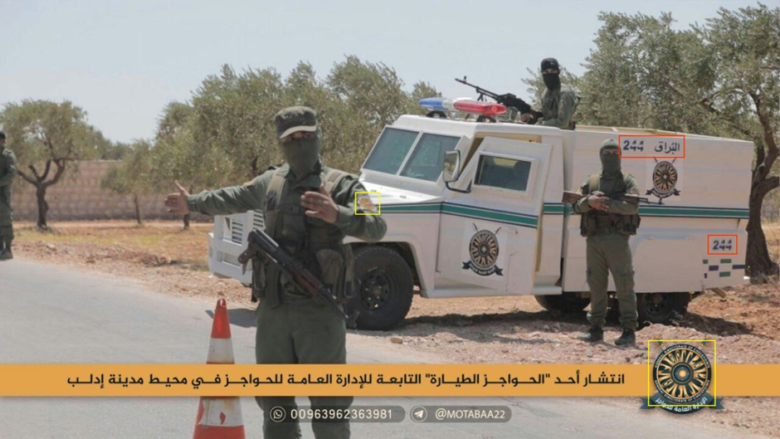 Image (4) – The very same vehicle (al-Buraq 244) seen in an image published by the HTS General Administration for Checkpoints in August 2020 (source).
Image (4) – The very same vehicle (al-Buraq 244) seen in an image published by the HTS General Administration for Checkpoints in August 2020 (source).
 Image (5) – HTS al-Buraq vehicle #244 seen at Afrin’s ‘Newroz circle’ on 14 October 2022 (source).
Image (5) – HTS al-Buraq vehicle #244 seen at Afrin’s ‘Newroz circle’ on 14 October 2022 (source).
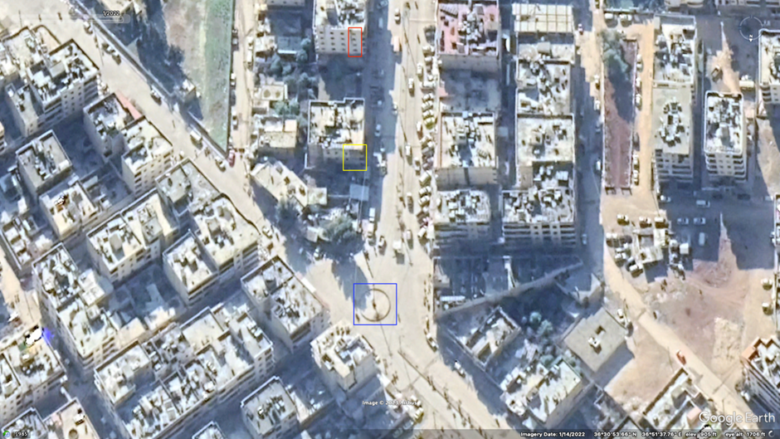 Image (6) – Geolocation of image (5). Coordinates: 36.515150, 36.860419.
Image (6) – Geolocation of image (5). Coordinates: 36.515150, 36.860419.
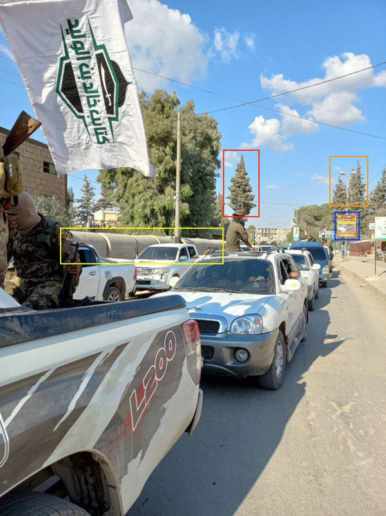 Image (7) – A convoy of fighters from HTS’s Khalid bin al-Walid Brigades in Afrin city, 14 October 2022 (source ).
Image (7) – A convoy of fighters from HTS’s Khalid bin al-Walid Brigades in Afrin city, 14 October 2022 (source ).
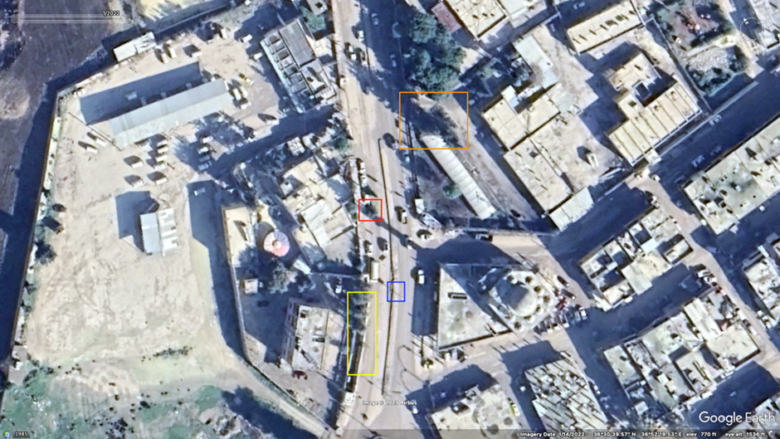 Image (8) – Geolocation of image (7). Coordinates: 36.510429, 36.871574.
Image (8) – Geolocation of image (7). Coordinates: 36.510429, 36.871574.
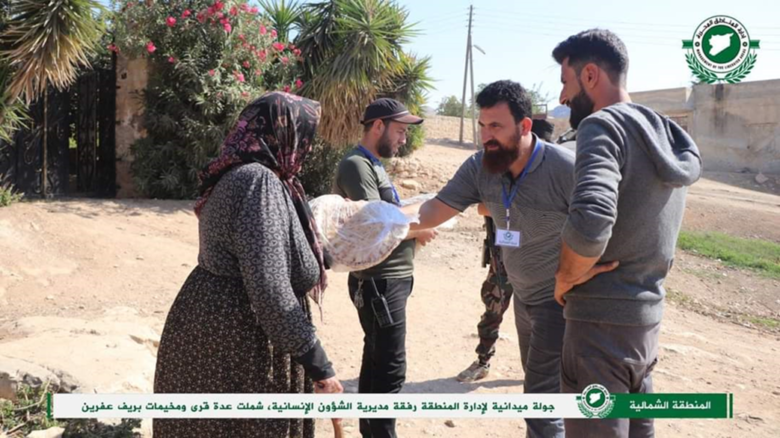 Image (9) – Members of the HTS-affiliated Syrian Salvation Government distribute bread in Afrin on 14 October 2022 (source).
Image (9) – Members of the HTS-affiliated Syrian Salvation Government distribute bread in Afrin on 14 October 2022 (source).
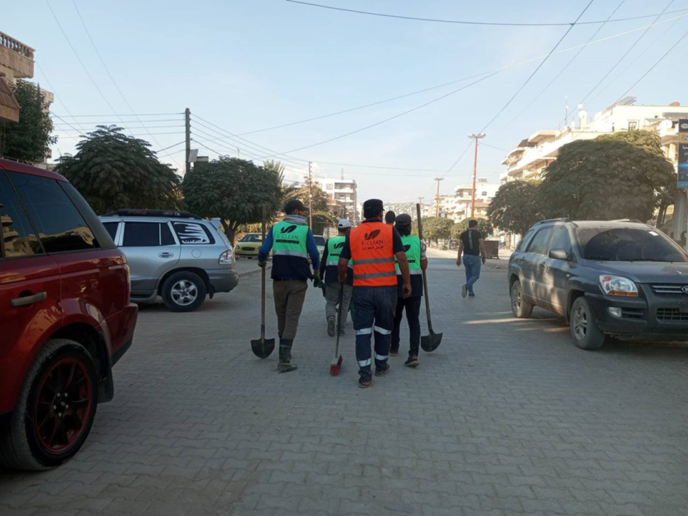 Image (10) – Members of the HTS-linked, Idlib-based E-Clean waste management company seen in Afrin city on 14 October 2022 (source).
Image (10) – Members of the HTS-linked, Idlib-based E-Clean waste management company seen in Afrin city on 14 October 2022 (source).
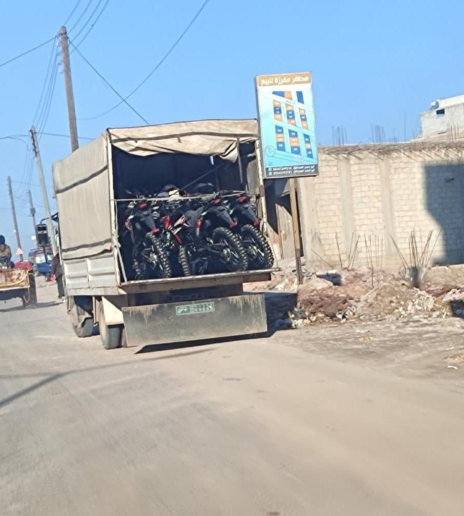 Image (11)
Image (11)
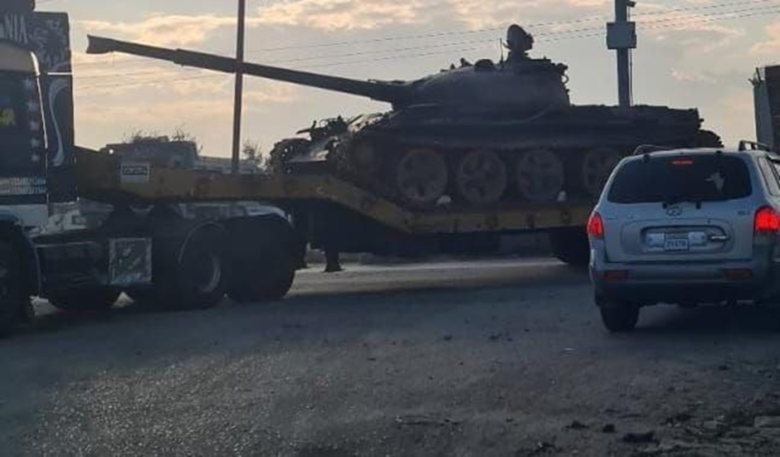 Image (11 & 12) – Photos reportedly showing HTS vehicles being transported to Afrin from Idlib in early January 2023. STJ was unable to confirm the location of the vehicles yet. (source).
Image (11 & 12) – Photos reportedly showing HTS vehicles being transported to Afrin from Idlib in early January 2023. STJ was unable to confirm the location of the vehicles yet. (source).
5. The Earthquake Boosts the HTS Presence in Afrin
The earthquake that rocked several areas in southern Türkiye and northern Syria, killing thousands of people, confirmed that the HTS was still in the Afrin region despite the truces under which the HTS had to remove its forces. Additionally, the HTS-founded Syrian Salvation Government (SSG) took a leading position in the service field following the quakes. The HTS deployed personnel to the Jindires district particularly, while its service departments partook in rubble removal, rescue, and recovery of bodies operations.
To verify the HTS’s presence in the region, STJ interviewed several sources, including a relief worker. The sources confirmed the HTS’s participation in the post-quake response operations. A high-ranking officer from the HTS (source 12) narrated:
“The HTS sent heavy machinery, fuel, equipment, and aid to Jindires, under the security agreement it has signed with the al-Hamza/al-Hamzat Division and the Suleiman Shah Brigade (also known as al-Amshat). With the assistance, [the HTS] sought to present the SSG’s success in managing crises and filmed several videos of the aid deliveries in Jindires to prove this. Nevertheless, the SSG underperformed in Idlib, and both machinery and fuel were lacking. As a result, there were complaints among the HTS fighters and several high-ranking officers, even though the SSG prioritized rescuing HTS fighters and officers affected in the quake in Idlib.”
The officer added:
“In Jindires, the HTS received aid shares from the organizations operating in the region like the rest of the SNA factions. The HTS took 25% of the relief assistance. Additionally, the Suleiman Shah Brigade (also known as al-Amshat) asked the HTS to control security. Indeed, the HTS sent forces, captured several thieves, and transported them to Idlib for trials.”
For his part, the relief worker Muhammad, a volunteer with one of the rescue teams in Jindires (source 13), narrated:
“During the search and rescue operations, many people came to Jindires to search and steal money and gold in the debris of destroyed homes or those abandoned by owners. After this, we saw several HTS security and military groups spread in hit areas. The groups started to establish security using force. Additionally, teams that wanted to participate in rescue efforts had to refer to the HTS first. Then, the HTS would investigate them and send away those it suspected from the area. Moreover, HTS fighters shot their guns at a group of thieves. They injured one and arrested the rest.”

